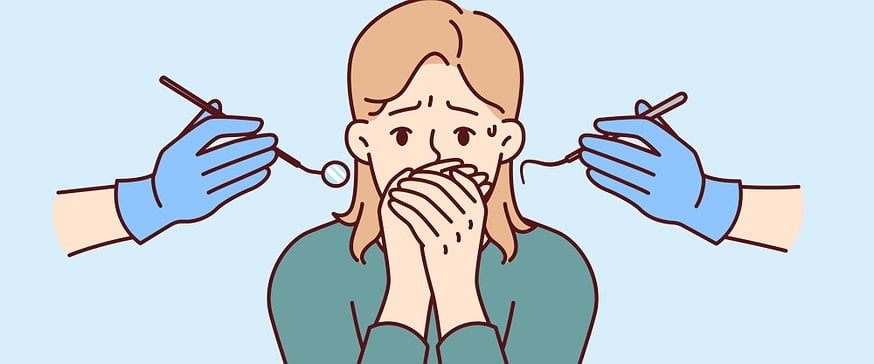
Understanding Dentophobia: Breaking Free from Dental Anxiety
Do dentist visits make you anxious? You are not on your alone. Many people have extreme fear, also referred to as dentophobia, when they consider sitting in a dentist's chair. This anxiety goes beyond simple discomfort; it can deter people from getting necessary treatment, which results in long-term medical effects. First step in properly managing the dentophobia is knowing its meaning and effects. Stress-free dentist appointments may be reality with the correct techniques and help.
Key Takeaways
Dentophobia, one common worry affecting dental and general health is the anxiety of visiting the dentist.
Learning the dentophobia meaning, symptoms, and causes helps in addressing this challenge effectively.
Various dentophobia treatments ensure a more comfortable dental experience.
Distinguishing between odontophobia vs dentophobia allows for tailored approaches.
What Is Dentophobia?
Dentophobia, often known as the dread of dentists, is a severe, frequently incapacitating anxiety related to dental environments or treatments. Unlike typical dental fear, dentophobia can force patients to completely postpone dental treatment, therefore compromising their risk of major health problems.
The dentophobia definition traces its roots to Greek, with “odous” meaning tooth and “phobos” meaning fear. While it’s often confused with odontophobia, the two terms differ slightly. Odontophobia vs dentophobia reveals that odontophobia refers to a broader fear of dental procedures, whereas dentophobia specifically focuses on the fear of dentists or dental environments.
How Common Is Dentophobia?
Dental fear is remarkably widespread. Research suggests that up to 36% of individuals experience dental anxiety, while 10-15>#/b### suffer from severe dentophobia (Armfield, 2010). This makes it among the most common phobias; usually beginning in childhood and continuing throughout age if neglected.
Recognizing Dentophobia Symptoms
Identifying dentophobia symptoms can help individuals take the first steps toward addressing the condition. These symptoms may include:
Physical Responses: Rapid heartbeat, sweating, nausea, or faintness.
Emotional Reactions: Feelings of dread, panic, or helplessness at the thought of dental visits.
Behavioral Patterns: Avoidance of appointments, even when dental care is necessary.
Although the severity of these symptoms varies, they are frequently brought on by unpleasant memories, a fear of pain, or sensory triggers like the sound of a drill. (Hill et al., 2013).
Common Causes of Dentophobia
The dentophobia problem can arise from various factors, including:
Previous Trauma: Painful or distressing dental visits, often during childhood.
Fear of Pain: Misconceptions about dental procedures can amplify fear.
Loss of Control: The vulnerability of being in a dentist’s chair.
Sensory Overload: Smells, sounds, and sights in dental clinics that trigger anxiety.
Learned Behavior: Observing others’ fear or hearing negative stories about dentistry.
Knowing these reasons helps people as well as experts create workable answers.
Impact of Dentophobia on Health
Avoiding dental care due to dentophobia symptoms can have far-reaching effects:
Oral Health Issues: Delayed care leads to cavities, gum disease, and tooth loss (Peres et al., 2019).
Overall Health Risks: Poor oral health contributes to systemic conditions such as diabetes and heart disease (Sanz et al., 2020).
Mental Health Strain: Persistent anxiety over dental visits can worsen stress levels and affect quality of life.
Addressing the dentophobia problem early is crucial for both physical and emotional well-being.
Effective Dentophobia Treatments
Overcoming dentophobia requires a combination of strategies that address the root cause and provide immediate relief. Here are some practical approaches:
1. Gradual Desensitization
Start with small, non-invasive procedures, like cleanings, to rebuild confidence. Over time, progress to more involved treatments.
2. Communicating with Your Dentist
An open dialogue with a compassionate dentist can make all the difference. Many dentists are trained to help anxious patients feel at ease.
3. Sedation Options
For severe cases, sedation dentistry offers a solution:
Nitrous Oxide: Reduces anxiety without losing consciousness.
Oral Sedation: Pills taken before appointments to calm nerves.
IV Sedation: Provides deeper relaxation for significant fear.
4. Relaxation Techniques
Simple methods like deep breathing, guided imagery, or listening to soothing music during visits can significantly reduce stress.
5. Cognitive Behavioral Therapy (CBT)
CBT helps reframe negative thoughts about dental care, providing a long-term solution to anxiety (Fjermestad et al., 2020).
Odontophobia vs Dentophobia: Why the Difference Matters
While they overlap, understanding odontophobia vs dentophobia clarifies treatment approaches. Odontophobia relates to fears of specific procedures, whereas dentophobia is often tied to the interpersonal and environmental aspects of dental care.
Summing Up
Despite its prevalence, dentophobia is a disorder that can be effectively managed. Knowing its causes, symptoms, and remedies helps people to take charge of their dental situation. Overcoming the dentophobia issue is within grasp whether by therapy approaches, sedation dentistry, or slow exposure.
Break free from the clutches of fear and anxiety. Start your road towards a better smile right now by looking at the choices at your disposal.
References
Armfield, J. M. (2010). Development and psychometric evaluation of the Index of Dental Anxiety and Fear (IDAF-4C+). Psychological Assessment, 22(2), 279-287. https://doi.org/10.1037/a0018678
Fjermestad, K. W., Oppedal, B., & Belsky, J. (2020). Dental phobia: Cognitive-behavioral treatments for individuals with dental fears. Clinical Psychology Review, 76, 101819. https://doi.org/10.1016/j.cpr.2019.101819
Hill, K. B., Hainsworth, J. M., Burke, F. J., & Fairbrother, K. J. (2013). Evaluation of dental anxiety in patients attending a university dental hospital in the UK. British Dental Journal, 215(10), E17. https://doi.org/10.1038/sj.bdj.2013.1094
Peres, M. A., Macpherson, L. M., Weyant, R. J., et al. (2019). Oral diseases: A global public health challenge. The Lancet, 394(10194), 249-260. https://doi.org/10.1016/S0140-6736(19)31146-8
Sanz, M., Marco Del Castillo, A., Jepsen, S., et al. (2020). Periodontitis and cardiovascular diseases: Consensus report. Journal of Clinical Periodontology, 47(3), 268-288. https://doi.org/10.1111/jcpe.13189




















